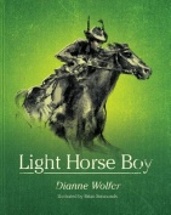Light Horse boy by Dianne Wolfer

Ill. by Brian Simmonds. Fremantle Press, 2013 ISBN 978 1922 089 137.
(Age: 9+) Warmly recommended. World War One. ANZAC. Animals. In a
handsomely produced hard cover book with a large number of photos
from WW1, Wolfer tells the tale of young Jim, joining his older
friend, Charlie on the big adventure overseas, taking their horses
along with them. Australia's involvement in the European war has
been declared and the two present themselves to the local
recruitment tent for the medical.
With stunning illustrations by Simmonds, each page is a treat. Many
pages are presented in the form of pages torn from a diary or pages
of letters from family, each shown as carefully folded and worn to
give a better impression to the reader of what war was like for the
ordinary man and his family, opening and closing the few treasured
letters many times. Numbers of photos show the range of
animals kept by the soldiers as mascots, while others reflect the
plight of the horses taken from Australia to the Middle East in
particular.
Jim and Charlie are part of the 4th Light Horse Brigade, and so the
story follows their actions, showcasing for the reader a small part
of the whole war, enabling younger readers to get some sense of the
conditions in which they lived, the constant fear, the privations,
the loneliness amid the friedndships.
There has been a bag full of books published in the past twelve
months or so on Australia's involvement in the wars since the Boer
War. Each has taken a different perspective, be it a young boy
signing up in Alan Tucker's Gallipoli, or Jackie French's The girl
from Snowy River showing the impact of war on a rural community, or
The horses didn't come home by Pamela Rushby, the tale of the fate
of the 130,000 Walers sent to war, and To brave the seas by David
McRobbie, about the men who served on the Merchant Navy during WW2,
each has a different tale to tell, impelling our younger readers to
think more deeply about war and its impact.
This book is hard to put down, its illustrations and spare prose
will grab the readers and keep them reading. Information at the
start of the book verifies the tale of the one horse that did make
it back to Australia, and the map and acknowledgments at the end
show where some of the photos have come from, making the book most
useful if looking at war in the classroom. With the centenary of
World War One looming in 1914, and the centenary of the landing at
Anzac Cove the following year, these books are the first of many,
offering a perspective which will appeal to a wide range of readers.
Fran Knight